한국 역사 속 영웅을 세계인들에게 이야기하며 직지를 알려요!
대한민국은 오천 년의 역사를 가진 나라입니다. 이 오랜 역사 속에는 오늘날 한국인들이 사랑하는 여러 영웅이 있습니다. 각 나라의 전성기를 이끌었던 뛰어난 왕들이 있습니다. 그러나 모든 영웅이 모두 높은 지위의 사람들은 아닙니다. 재능은 뛰어났으나 신분이 낮아 큰 어려움을 겪었던 발명가와 의학자가 있습니다. 기존의 지식에 저항하여 새로운 도전을 펼쳤던 과학자, 장군, 화가가 있습니다. 또한, 평범한 삶을 살았지만 마주한 과제를 포기하지 않고 위대한 꿈을 꾸고 역사를 변화시켜 나간 평범하지만 위대한 한국인들이 있습니다.
직지의 존재를 세상에 알린 박병선 박사또한 평범하지만 위대한 영웅입니다.
프랑스 국립 도서관에서 직지를 발견하고 온갖 어려움과 시련을 극복하고 직지의 가치를 세상에 알린 박병선 박사의 이야기는 세계인들에게 큰 감동을 줄수 있습니다.
현존하는 세계 최고의 금속활자본 직지를 세계인에게 알린 박병선 박사와 함께 한국의 역사 속에서 살아 숨 쉬는 찬란한 영웅들을 세계인에게 알려주세요.
 잃어버린 세계 최고(最古) 금속활자본을 찾아낸 박병선과 뛰어난 한국인쇄술의 증거 직지
잃어버린 세계 최고(最古) 금속활자본을 찾아낸 박병선과 뛰어난 한국인쇄술의 증거 직지
박병선(1927-2011)은 한국의 역사학자이다. 세계에서 가장 오래된 금속활자본인 고려(918-1392)의 <직지심체요절(직지)>과 조선의 왕실 행사 보고서인 <외규장각의궤>를 발견하여 세상에 알렸다. 현재 두 기록은 모두 유네스코 세계기록유산으로 등재되어있다. 박병선은 일제강점기에 태어나 1955년 프랑스로 유학을 떠났다. 파리 국립도서관에서 근무하면서 도서관에 소장되어 있던 직지를 1972년 파리 도서전시회에 출품하여 세계에 알렸다. 직지는 1377년 청주 흥덕사에서 발행된 불교서적이다. 박병선과 청주고인쇄박물관의 노력으로 직지는 세계기록유산에 등재되었다. 세계 최초의 금속활자본 직지를 발견하고 세계에 알리는데 헌신한 박병선은 직지대모로 불린다.
“이제 우리는 용기를 내어 금속활자 발명의 영광을 그 주인인 동양인(한국인)에게 돌려줘야 합니다.”
-루이 듀셰 (프랑스 최대 민영방송 TF1 기자) 1972년 ‘책’ 전시회의 ‘직지’ 소개 중
Park Byeongseon and Jikji
Park Byeongseon was a Korean historian, who discovered Jikji, the world’s oldest extant book printed with movable metal type, proving Korea’s advanced printing technology.
Park Byeongseon (1927 – 2011) is a Korean historian. She found JikjiSimcheYojeol(Jikji for short) from the Goryeo era (918 – 1392), the world’s oldest extant book printed with movable metal type, and the OwegyujanggakUigwe, a collection of royal protocols of Joseon. Both assets are inscribed on the UNESCO Memory of the World Register. Park was born during Japanese occupation (1910-1945) and went to France in 1955 to study. While she was working at the National Library of France, she introduced Jikji to the public at a 1972 book fair in Paris. Jikji is a Buddhist document that was printed at Heungdeok Temple in Cheongju in 1377. Park and Cheongju Early Printing Museum helped Jikji to achieve its status as a UNESCO Memory of the World asset. Park is called the Mother of Jikji for her dedication to finding and promoting Jikji.
“Now we need to have the courage to give the honor for inventing movable metal type to its legitimate holder, Asian (Korean).”
– Louis Duche (Reporter of TF1, biggest private channel in France), introducing Jikji at the Paris book fair in 1972.
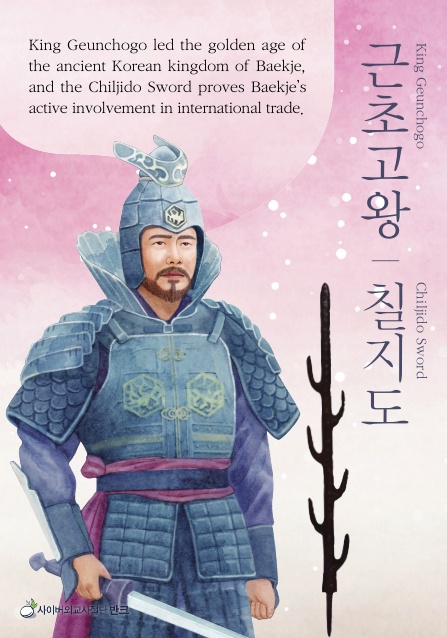 한국의 고대왕국 백제의 전성기를 이끈 근초고왕과 백제의 활발한 교류의 증거 칠지도
한국의 고대왕국 백제의 전성기를 이끈 근초고왕과 백제의 활발한 교류의 증거 칠지도
근초고왕 (재위: 346-375) 은 한국의 고대왕국 백제(18 BC-AD 660)의 13대 왕으로 백제의 전성기를 이끌었다. 활발한 정복 활동을 펼쳤고 역사서를 편찬하였으며, 수도를 확장하고, 해상 무역을 발전시켜 강력한 백제를 건설하였다. 중국의 기록에 따르면 근초고왕 시대에 백제는 중국의 요서 지역에까지 진출하였다.또한, 백제는 일본과도 활발히 교류하였는데 일본에 선진 문물을 전해주고 일본은 백제에 용병을 제공하였다. 당시 두 나라의 교류를 보여주는 유물이 칠지도이다. 칠지도는 일본의 이소노카미신궁에 소장된 국보로 369년 백제가 일본 왕에게 하사한 칼이다. 74.9cm의 길이에 금상감 명문이 새겨져 있으며 당시 백제의 뛰어난 제철 기술을 엿볼 수 있다.
“백제왕이 왜왕 지를 위하여 만들었으니 후세에 길이 전해야 할 것이다.” -칠지도 명문 중
King Geunchogo and Chiljido Sword
King Geunchogo led the golden age of the ancient Korean kingdom of Baekje, and the Chiljido Sword proves Baekje’s active involvement in international trade.
King Geunchogo (Reign: 346 – 375) was the 13th ruler of the ancient Korean kingdom of Baekje (18 BC – AD 660). He led the golden age of Baekje. He expanded its capital and enriched the kingdom culturally and economically byleading military campaigns, engaging in maritime trade, and publishing history books. According to Chinese records, Geunchogo expanded its territory to include the Liaoxi area in Northeast China. Baekje and Japan had a reciprocal relationship. Baekje passed advanced culture to Japan while Japan sent mercenaries to Baekje. Their relationship is evidenced by the Chiljido or Seven-branched sword. Designated as a Japanese national treasure and housed in Japan’s Isonokami Shrine, the sword was given as a gift to a Japanese king from Baekje’s king in 369. This 74.9cm-long sword is engraved with characters in gold, and the sword itself shows Baekje’s advanced iron-working skills.
“Baekje’s King ordered that this sword be made for Shi, King of Japan. The sword shall be passed down through the generations.”
– From the Inscription on the Chiljido Sword.
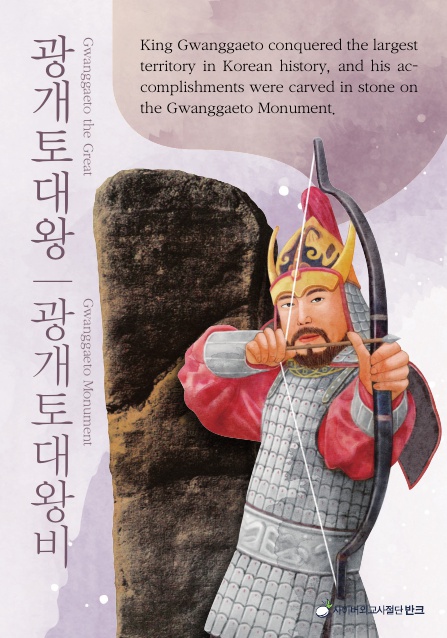 한민족 역사상 가장 넓은 영토를 개척한 광개토대왕과 그의 역사가 기록된 광개토대왕비
한민족 역사상 가장 넓은 영토를 개척한 광개토대왕과 그의 역사가 기록된 광개토대왕비
광개토대왕(374-412)은 고구려(37 BC – AD 668)의 제19대 왕으로 한민족 최고의 정복군주이다. 고구려는 지금의 한반도 북부와 중국의 북동부지역을 무대로 발전한 한국의 고대국가로 전투능력이 뛰어난 개마무사를 주축으로 정복 전쟁을 수행해 넓은 영토를 차지하였다. 광개토대왕은 고구려의 대표적인 왕으로 한국 최초로 독자적인 연호를 사용하였으며 한국 역사상 가장 넓은 영토를 개척하였다. 이러한 광개토대왕의 업적은 광개토대왕비에 잘 남아있다. 광개토대왕비는 중국의 지린성 지안현에 있는데 대왕의 사후에 그의 아들이 세웠으며 높이 6.39m의 비석 4면에 1775자가 힘 있는 서체로 새겨져 있다.
“왕의 은택이 하늘까지 미쳤고, 위엄은 온 세상에 떨쳤다.” -광개토대왕비문
Gwanggaeto the Great and Gwanggaeto Monument
King Gwanggaeto conquered the largest territory in Korean history, and his accomplishmentscarved in stoneon the Gwanggaeto Monument.
Gwanggaeto the Great (374 – 412) was the 19th ruler of the ancient Korean kingdom of Goguryeo (37 BC – AD 668). He was the most successful conqueror in Korean history. Armed with a strong ironclad cavalry, Goguryeo conquered the northern Korean peninsula and a large portion of northeastern China. Gwanggaeto was the most respected king of Goguryeo who adopted an independent era name and occupied the largest territory in Korean history. His accomplishments are well-documented on the Gwanggaeto Monument. The monument was erected after his death by his son. Located in Jian in China’s Jilin Province, the monument is a 6.39-meter-tall stele engraved with 1,775 characters on its four sides.
““King’s grace reached heaven and his power reached the whole world.”” – From the Inscription on the Gwanggaeto Monument
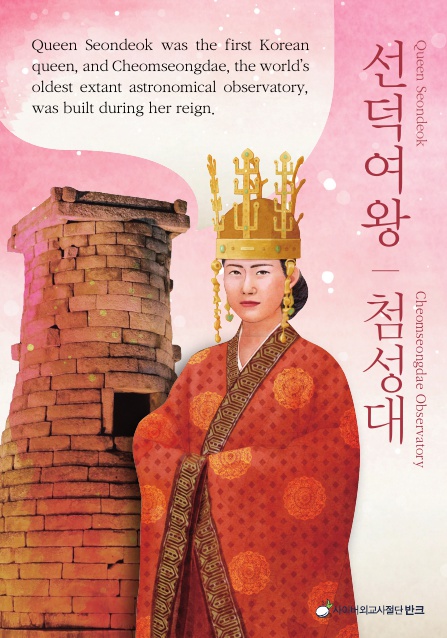 한민족 최초의 여왕 선덕여왕과 그 시대에 세워진 세계 최고(最古)의 천문대 첨성대
한민족 최초의 여왕 선덕여왕과 그 시대에 세워진 세계 최고(最古)의 천문대 첨성대
선덕여왕 (재위 632-647)은 한국의 고대왕국 신라(57 BC – AD 935)의 27대 왕으로 신라 최초의 여왕이다. 여성으로 왕위에 올라 여러 편견과 싸워야 했고 내부의 반란과 백제와 고구려의 공격도 이어졌지만 이러한 위기를 잘 극복하고 신라가 삼국을 통일할 수 있도록 기반을 마련하였다. 한국의 역사서들은 신라의 선덕여왕을 지혜로운 여왕으로 기록하고 있다. 첨성대는 선덕여왕 재위 기간에 축조된 세계에서 가장 오래된 천문대이다. 높이는 약 9.5m로 신라의 수도였던 경주에 있다. 역법을 만들기 위해 별을 관측하고, 여러 천문 현상을 관찰하여 국가의 길흉을 점치는데 사용되었을 것으로 짐작된다.
“많은 신하들은 모두 그 뛰어난 지혜에 감복하였다.” – 『삼국유사』
Queen Seondeok and Cheomseongdae Observatory
Queen Seondeok was the first Korean queen, and Cheomseongdae, the world’s oldest extant astronomical observatory, was built during her reign.
Queen Seondeok (Reign: 632 – 647) was the 27th ruler of the ancient Korean kingdom of Silla (57 BC – AD 935) and the first woman to rise to the throne in Korean history. Being a woman, she had to fight many stereotypes and confronted with revolts and attacks from Baekje and Goguryeo. She overcame all the challenges and laid the foundation for Silla to unify the three kingdoms. She is described as a wise queen in Korean history books. Cheomseongdae is the oldest extant astronomical observatory, built during her reign. This 9.5-meter-tall observatory remains in Silla’s capital, Gyeongju. It is assumed that the observatory was used to observe stars and astronomical events for the prediction of the kingdom’s fate.
“Servants were moved by the queen’s excellent wisdom.” – Excerpt from 『Samgukyusa』 (Memorabilia of the Three Kingdoms)
 한민족 최초 화약 개발자 최무선과 시대를 이어 민족을 지켜낸 그의 함포
한민족 최초 화약 개발자 최무선과 시대를 이어 민족을 지켜낸 그의 함포
최무선 (1325-1395)은 고려 시대(918-1392)의 무인으로 한국 역사상 최초로 화약을 발명하였다. 화약의 중요성을 인식한 최무선은 화약제조법을 익히고, 정부에 화약과 화기 제조를 담당하는 기관의 설치를 건의하여 화포를 개발하였다. 이렇게 고려는 20여 종에 달하는 화기를 제조하였고 1380년 최무선이 발명한 화포를 주 무기로 진포해전에서 수백 척의 왜선을 격퇴하였다. 진포해전은 세계 최초의 함포 해전으로 서양 최초의 함포 해전인 레판토 해전(1571년)보다 190여 년이 앞선다. 최무선이 발명한 고려의 화약과 무기는 조선(1392-1910)으로 이어져 임진왜란 때 해전에서 일본을 격퇴하는 중요한 요인이 되었다.
“나라를 위해 마음을 썼으므로 능히 이원의 기술을 얻었으니 그 사려가 깊고 멀다 하겠다.”- 화약고기
Choi Museon and Naval Gun
Choi Museon invented the first Korean domestic gunpowder, and Korean history, his naval gun defended the Korean people.
Choi Museon (1325 – 1395) was a military commander during Goryeo (918 – 1392) who produced the first domestic gun power in Korean history. In recognition of the importance of gunpowder, Choe produced gun powders and cannons by learning the necessary techniques and persuading the government to establish a firearms production office. Goryeo produced more than 20 kinds of firearms. Choe’s cannons played a crucial role in defeating hundreds of Japanese vessels in the Jinpo Naval Battle in 1380. The Jinpo Naval Battle was the first naval gun battle, over 190 years earlier than the Battle of Lepanto (1571), the first naval gun battle in the West. Goryeo’s firearm-production techniques were passed down to Joseon (1392 – 1910) and contributed to defeating Japan during the Imjin War (1592 – 1598).
“Choe took great effort to get information about gunpowder from Lee Yuan. His loyalty to the country deserves great respect.” –Excerpt from 『Hwayakgogi』 (Records of Firearms)
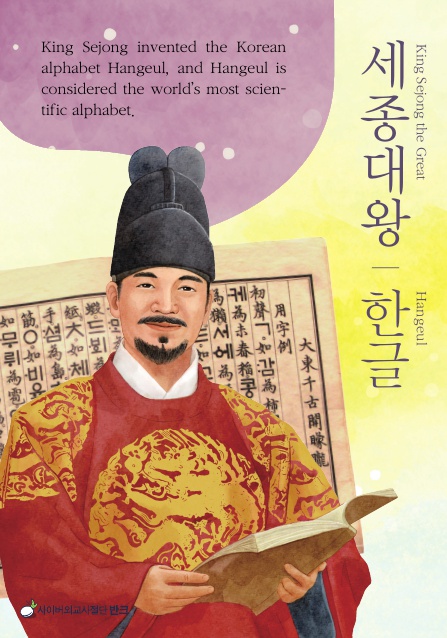 백성을 위해 글자를 만든 임금 세종대왕과 세계 최고(最高) 문자 한글
백성을 위해 글자를 만든 임금 세종대왕과 세계 최고(最高) 문자 한글
세종대왕(1397-1450)은 조선의 제4대 왕으로 백성들을 위해 한글을 창제하였다. 세종의 시대는 오 천년 한국역사상 가장 융성했던 시대로 꼽힌다. 정치, 경제, 사회, 문화, 국방 전 분야에서 주체적으로 의미 있는 발전을 이루었다. 세종의 여러 빛나는 업적 중에 가장 의미 있는 업적은 단연 한글 창제이다. 노비와 죄인들까지 생각하며 정책을 펼쳤던 세종대왕은 글을 몰라 어려움을 당하는 백성들을 위해 1443년 한글을 창제하였다. 이는 인류역사상 유례가 없는 일로, 간단하면서도 논리적이고 과학적인 한글은 세계 최고의 문자로 평가 받는다. 세종대왕은 또한 한글의 창제자, 창제일, 창제 동기와 그 원리를 담은 책을 발간하여 위대한 한글의 탄생을 정확히 전하고 있다.
“우리나라 말이 중국말과 달라 한자와 서로 잘 통하지 않는다. 이런 까닭으로 어린 백성이 말하고자 하는 바가 있어도 끝내 제 뜻을 능히 펴지 못하는 사람이 많다. 내가 이것을 가엾게 여겨 새로 스물여덟 글자를 만드니, 모든 사람으로 하여금 쉽게 익혀서 날마다 쓰는 데 편안하게 하고자 할 따름이다.”– 『훈민정음』 서문
King Sejong the Great and Hangeul
King Sejong invented the Korean alphabet Hangeul, and Hangeul is considered the world’s most scientific alphabet.
King Sejong the Great (1397 – 1450) was the 4th ruler of Joseon (1392 – 1910), who is best known for inventing the Korean alphabet of Hangeul. His reign (1418 – 1450) was one of the most prosperous periods in Korea’s 5000 years of history. During his reign, Joseon made significant accomplishments in all areas of politics, economy, society, culture, and national defense. The invention of Hangeulin particular made a lasting impact on the Korean society. He created Hangeul in 1443 to help commoners express their thoughts and feelings in writing. Creating an alphabet specifically designed to benefit commoners was unprecedented in history. Hangeul is regarded as one of the best alphabets for being logical, scientific, and easy-to-learn. Its inventor and the date, purpose, and principles of invention are clearly stated in the Hunminjeongeum Manuscript.
“The Korean language is different from Chinese, and it is not properly expressed in Chinese characters. For this reason, our people have difficulty expressing their thoughts and feelings in writing. I sympathize with them, and thus I created 28 letters in the hope that everyone can learn and use them easily every day.” – Preface to 『Hunminjeongeum』
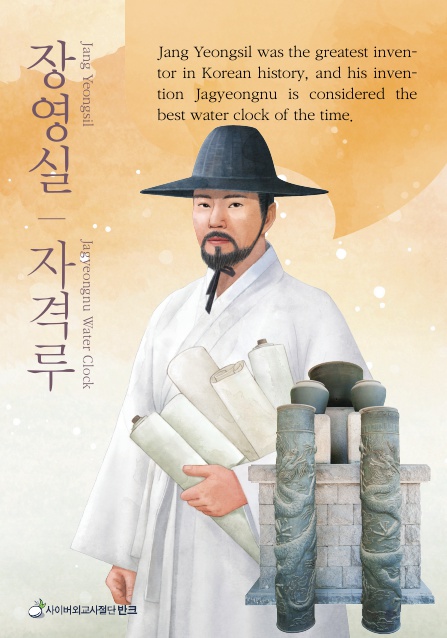 한민족 최고의 발명가 장영실과 그가 만든 조선 최고(最高) 물시계 자격루
한민족 최고의 발명가 장영실과 그가 만든 조선 최고(最高) 물시계 자격루
장영실은 조선왕조(1392-1910) 최고의 과학자이다. 노비 출신이었으나 재주가 뛰어나 궁궐로 발탁되었다. 조선의 제4대 세종대왕은 이런 장영실을 눈여겨보고 크게 발전시켜주었다. 1421년 세종대왕은 장영실을 중국으로 유학 보내어 각종 천문 기구를 공부하게 하였고, 노비 출신인 그에게 관직을 주고 여러 과학기구를 제작하게 하였다. 자격루는 1434년 장영실이 왕명을 받아 제작한 자동으로 시간을 알려주는 기능이 있는 한국 최초의 자동 물시계이다. 이 밖에도 장영실은 조선 최초의 천문관측대인 간의대와 여러 천문관측기구, 여러 해시계와 동활자 등 수많은 과학기구를 발명하였다.
“장영실은 시대를 위해 태어난 인물이다” – 서거정 『필원잡기』
Jang Yeongsil and Jagyeongnu Water Clock
Jang Yeongsil was the greatest inventor in Korean history, and his invention Jagyeongnu is considered the best water clock of the time.
Jang Yeongsil was a genius engineer during Joseon (1392 – 1910). He was born a slave but was brought to the royal palace due to his extraordinary talent. In recognition of his talent, King Sejong the Great (1397 – 1450) supported his career development. The king sent Jang to China in 1421 to study astronomical instruments. Despite his class, Jang was given an official position and tasked with developing scientific instruments. On the king’s command, he invented Korea’s first self-striking water clock called Jagyeongnu in 1434. He also invented many other scientific instruments, including Joseon’s first astronomical observatory Ganuidae and various astronomical tools, sundials, and copper types.
“Jang Yeongsil is a man born for our time.” – Excerpt from 『Pilwonjapgi』 by SeoGeojeong
 위기의 나라를 구한 명장 이순신과 그의 창의적인 전함 거북선
위기의 나라를 구한 명장 이순신과 그의 창의적인 전함 거북선
이순신(1545-1598)은 조선 시대(1392-1910)의 장군으로 일본의 침략으로부터 나라를 구한 영웅이다. 일본은 1592년부터 1598년까지 두 차례에 걸쳐 대규모로 조선을 침략하였다. 이에 맞서 이순신 장군은 모든 해전을 승리로 이끌며 바다를 지켜내어 나라를 지켰다. 거북선은 이순신 장군이 전쟁을 대비해 만든 특수한 구조의 전함이다. 배의 갑판 위에 덮개를 씌우고 뾰족한 철침을 설치해 적의 공격에 직접 노출되지 않으면서도 활과 화약 무기로 적을 효과적으로 공격할 수 있도록 제작되었다. 전투에 대한 철저한 준비와 불굴의 정신은 이순신 장군을 불패의 명장으로 이끌었다. 대한민국 수도 서울 광화문 광장 한복판에는 이순신 장군의 동상이 서 있다.
“죽기를 각오하면 살고 살고자 하면 죽는다.” –이순신
Admiral Yi Sun-sin and Geobukseon
Yi Sun-sin was a naval commander who saved the country from a national crisis with a revolutionary warship – the turtle ship or Geobukseon in Korean.
Yi Sun-sin (1545-1598) was a naval commander during Joseon (1392-1910), who defended the country from Japan. Japan invaded Joseon twice with large forces from 1592 to 1598. Yi led victories in all naval battles against the Japanese forces. He built a turtle-shaped battleship called Geobukseon in preparation for the battles. Its deck was covered with metal spikes to shield itself while being able to strike the enemy with arrows and cannonballs. His grit and thorough preparation made him an unbeatable commander. His statue stands in the middle of Gwanghwamun Square in the South Korean capital of Seoul.
““If you risk your life, you shall live. If you try to save your life, you shall die.”” – Yi Sun-sin
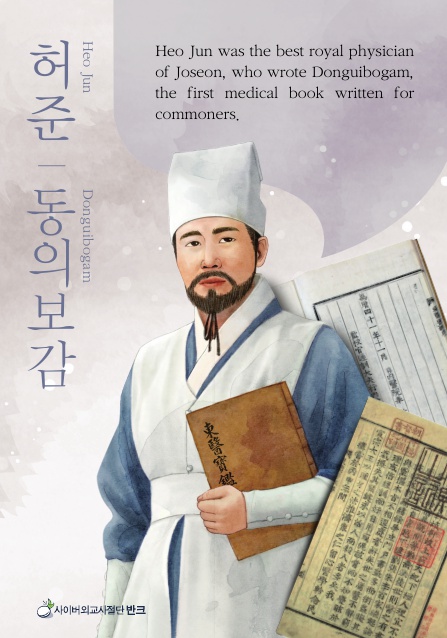 조선 최고(最高) 의학자 허준과 그가 저술한 일반 백성을 위한 최초의 의학서 『동의보감』
조선 최고(最高) 의학자 허준과 그가 저술한 일반 백성을 위한 최초의 의학서 『동의보감』
허준(1539-1615)은 조선 시대(1392-1910) 의학자로서 조선 최고의 의학서 『동의보감』을 집필하였다. 허준은 30여 년 동안 왕실 병원인 내의원에서 의원으로 활동하면서 수년간 연구와 임상시험을 통해 얻은 지식을 여러 의학서로 집필하여 동양 의학발전에 크게 기여하였다. 특히 1613년에 편찬된 『동의보감』은 허준의 대표적인 저서로 2000년 동안 축적된 동양 의학을 집대성한 의학서이다. 14년 동안 수백 권의 의학서들을 참고하여 저술하였으며 무엇보다 한국 실정에 맞게 일반 백성들이 주변에서도 쉽게 찾을 수 있는 약재를 백성들이 사용하는 한글 이름으로 소개하였다. 지금까지 중국, 일본 등에서 30여 차례 출간되었으며 오늘날에도 한의학도들에게 널리 읽히고 있다.
천하의 보물(동의보감)을 만든 사람 – 허준에 대한 중국의 평가
Heo Jun and Donguibogam
Heo Jun was the best royal physician of Joseon, who wrote Donguibogam, the first medical book written for commoners.
Heo Jun (1539 – 1615) was a doctor during Joseon (1392 –1910) who wrote Donguibogam, the first medical book for commoners. Heo wrote many medical books using his 30 years of experience as a royal physician and his clinical experiments, contributing to the development of Eastern medicine. Published in 1613, Donguibogam is his most-recognized work that compiled 2000 years of Eastern medical knowledge. For 14 years, he researched hundreds of medical booksand included a list of common names of medicinal herbs that were readily accessible to ordinary Koreans. This book was published in over 30 editions abroad, including in China and Japan, and it is still read by medical students today.
He is the man who created a treasure (Donguibogam) for the world. – Chinese evaluation of Heo Jun
 울릉도와 독도를 지켜낸 민간외교관 안용복과 한국인에게 가장 의미 있는 영토 독도
울릉도와 독도를 지켜낸 민간외교관 안용복과 한국인에게 가장 의미 있는 영토 독도
안용복은 조선왕조 숙종 시대(1661-1720)의 어부이자 조선의 영토를 지켜낸 민간외교관이다. 안용복은 1693년과 1696년 두 차례에 걸쳐 일본에 건너가 울릉도와 독도가 조선의 영토임을 밝히고 돌아왔는데, 당시 안용복이 지켜낸 동해의 독도는 오늘날 한국인들에게 가장 의미 있는 영토가 되었다. 왜냐하면, 독도는 20세기 초 일본 제국주의 침략의 첫 번째 희생물로서 일본에 빼앗겼다가 광복과 함께 다시 찾은 영토이기 때문이다. 한국인들은 독도를 바라보며 대한민국의 독립과 주권을 생각하고 영토 수호 의지를 다집니다.
“조선의 강원도 안에 울릉도와 독도가 있다.” – 일본의 원록구병자년 조선주착안일권지각서(1696)
An Yong-bok and Dokdo
An Yong-bok is a citizen diplomat, who defended the Korean islands of Ulleungdo and Dokdo, and Dokdo is the most meaningful island to Koreans.
An Yong-bok was a fisherman and citizen diplomat who defended a territory of Joseon (1392 – 1910) under the reign of King Sukjong (1661-1720). He visited Japan twice, in 1693 and in 1696, to clarify Joseon’s sovereignty over Ulleungdo and Dokdo. Dokdo in the East Sea is the most meaningful territory to the Korean people. Because Dokdo was the first Korean territory to fall victim to Japanese imperialism in the early 20th century. It was returned to Korea when Korea regained its independence. For Koreans, Dokdo signifies Korea’s full independence and sovereignty.
““Ulleungdo and Dokdo belong to Gangwondo, Joseon.”” – Japanese memorandum on the Arrival of a Boat from Joseon in 1696
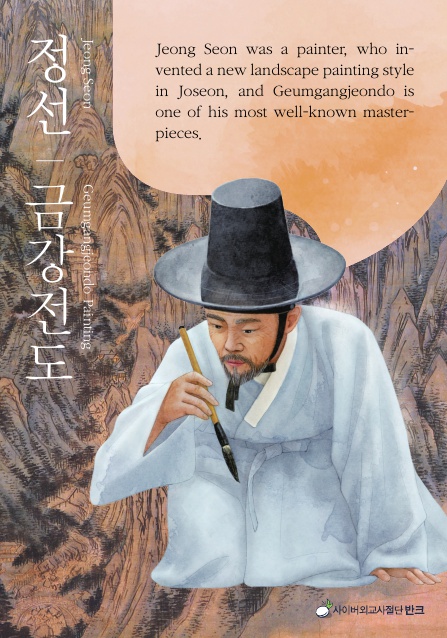 한국 고유의 화풍을 개척한 조선의 화가 정선과 그의 뛰어난 재능이 남긴 명작 금강전도
한국 고유의 화풍을 개척한 조선의 화가 정선과 그의 뛰어난 재능이 남긴 명작 금강전도
정선 (1676-1759)은 한국 고유의 화풍인 진경산수화를 개척한 조선 시대의 화가이다. 당시 화가들은 머릿속에 상상한 산수화를 그렸다. 정선은 이러한 화풍에서 벗어나 한국의 자연을 직접 답사하고 이를 소재로 산수화를 그렸다.국보 제217호인 <금강전도>는 정선의 대표작이다. 금강산은 예로부터 많은 사람들에게 널리 알려진 명산으로 정선도 금강산에 여러 차례 오르고 30대 후반부터 많은 작품을 남겼다. 정선의 이 <금강전도>는 하늘 위에서 금강산을 내려다본 것 같은 독특한 구도에 웅장한 금강산의 모습이 정선의 뛰어난 솜씨로 힘차게 그려져 있다.
“제 발로 금강산을 두루 다녀보아도 머리맡에서 (내 그림을) 실컷 봄만 못하리라”- 정선<금강전도>발문
JeongSeon and Geumgangjeondo Painting
JeongSeon was a painter, who invented a new landscape painting style in Joseon, and Geumgangjeondo is one of his most well-known masterpieces.
JeongSeon (1676-1759) was a painter during Joseon (1392 –1910) who started a new tradition of true-view landscape painting, known as JingyeongSansuhwa. Painters at the time drew landscapes through their imagination. Breaking away from this tradition, Jeong visited real locations and drew what he actually saw. His painting of Mt. Geumgang called Geumgangjeondo (Korean National Treasure #217) is one of his most-known paintings. He visited Mt. Geumgang several times and created many paintings of the mountain because it had long been known as a beautiful mountain. Geumgangjeondo depicts the mountain from a high-angle view with strong brush strokes.
““My painting will give a better view of Mt. Geumgang than the view you will get on your feet.”” – JeongSeon’s remark on Geumgangjeondo
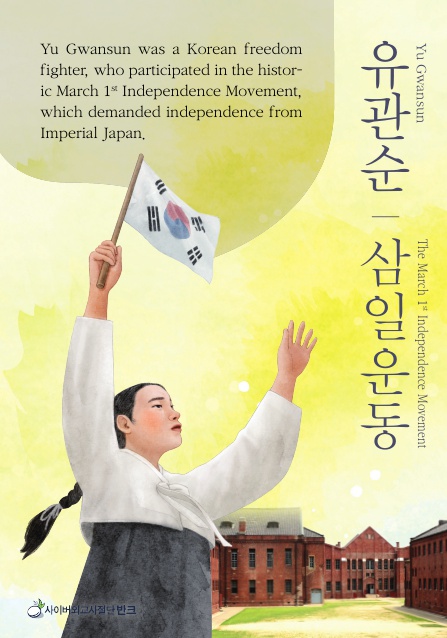 일본 제국주의에 맞선 한국의 독립운동가 유관순과 그녀의 꿈이 깃든 위대한 독립운동 3.1운동
일본 제국주의에 맞선 한국의 독립운동가 유관순과 그녀의 꿈이 깃든 위대한 독립운동 3.1운동
유관순(1902-1920)은 한국의 독립운동가이다. 1910년 일본 제국주의에 의해 강제로 나라를 빼앗긴 한국인들은 1919년 3월 1일을 기점으로 전국적으로 대규모 독립운동을 전개하였다. 당시 학생이었던 유관순은 서울에서 이 3.1운동에 참여하였고, 고향에 내려가 독립운동을 주도하다가 체포되어 이듬해 18세의 어린 나이에 감옥에서 순국하였다. 유관순이 참여했던 3.1운동은 한반도 전역에서 200만 명의 한국인들이 참여한 거족적인 독립운동이었다. 3.1운동을 통해 선포된 독립을 향한 한국인의 의지와 열망은 세계를 놀라게 하였고 중국의 5•4운동과 같은 세계 반제국주의 운동에 큰 영향을 끼쳤다.
“이제 우리는 우리 조선이 독립국임과 조선인이 자주민임을 선언한다”- 3.1독립선언서 중
Yu Gwansun and The March 1st Independence Movement
Yu Gwansun was a Korean freedom fighter, who participated in the historic March 1st Independence Movement, which demanded independence from Imperial Japan.
Yu Gwansun (1902 -1920) was a Korean freedom fighter. After Japan forcibly took control of Korea in 1910, Koreans started a nationwide independence movement on March 1, 1919, against Imperial Japan. Yu, then a student, participated in the movement in Seoul and later led the movement in her hometown of Cheonan. She was arrested and tortured to death at the age of 18. More than two million Koreans participated in the March 1st Independence movement across the country. Koreans’ strong will to regain independence, shown in the movement, surprised the world and influenced independence movements around the world and influenced anti-imperialism movements around the world, such as China’s May Fourth Movement.
““We herewith proclaim the independence of Korea and the liberty of the Korean people.““– Excerpt from Proclamation of Korean Independence